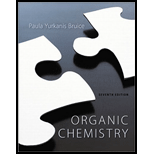
Concept explainers
a.
Interpretation:
Write the three different sets of reagents (each set containing of a carbonyl compound and Grignard reagent that would be used to prepare each of the following tertiary alcohols.
Concept introduction:
So many number of reactions are involved in the Carbonyl group. The carbonyl group is electrophilic nature, therefore it undergoes nucleophilic addition reactions.
For example carbonyl group reacts with Grignard reagent, it undergoes nucleophilic addition reactions and form unstable tetrahedral intermediate by the elimination of leaving group.
Addition of hydrogen ion to the carbonyl carbon to form alkoxide ion. By the protonation of alkoxide ion forms alcohol.
b.
Interpretation:
Write the three different sets of reagents (each set containing of a carbonyl compound and Grignard reagent that would be used to prepare each o the following tertiary alcohols.
Concept introduction:
So many number of reactions are involved in the Carbonyl group. The carbonyl group is electrophilic nature, therefore it undergoes nucleophilic addition reactions.
For example carbonyl group reacts with Grignard reagent, it undergoes nucleophilic addition reactions and form unstable tetrahedral intermediate by the elimination of leaving group.
Addition of hydrogen ion to the carbonyl carbon to form alkoxide ion. By the protonation of alkoxide ion forms alcohol.
Want to see the full answer?
Check out a sample textbook solution
Chapter 17 Solutions
Organic Chemistry (Looseleaf) - With Access
- Convert benzene into attached compound. You may also use any inorganic reagents and organic alcohols having four or fewer carbons. One step of the synthesis must use a Grignard reagent.arrow_forwardConvert benzene into each compound. You may also use any inorganic reagents and organic alcohols having four or fewer carbons. One step of the synthesis must use a Grignard reagent.arrow_forwardConvert benzene into each compound. You may also use any inorganic reagents and organic alcohols having three carbons or fewer. One step of the synthesis must use a Grignard reagent.arrow_forward
- Draw the structure of the carbonyl compound AND Grignard reagent which may be used to make the secondary alcohol shown below.arrow_forwardChoose a Grignard reagent _______and a ketone _______ that can be used to produce the following compound: 1-Ethylcyclohexanolarrow_forwardWhich of the following will not form an alcohol when reacted with 1 equivalent of Grignard reagent? A. acyl halide B. aldehyde C. ketone D. epoxidearrow_forward
- Convert benzene into attached compound. You may also use any inorganicreagents and organic alcohols having four or fewer carbons. One step of the synthesis must use a Grignard reagent.arrow_forwardWhat Grignard reagent and carbonyl compound are needed to prepare attached alcohol? As shown in part (d), 3° alcohols with three different R groups on the carbon bonded to the OH group can be prepared by three different Grignard reactionsarrow_forwardDraw the structures of a Grignard reagent and the corresponding carbonyl compound that could be used to prepare the secondary alcohol shown, using a Grignard reaction approach.arrow_forward
- What is the major product obtained when each of the following alcohols is heated in the presence of H2SO4?arrow_forwardWhat Grignard reagent and carbonyl compound are needed to prepare each alcohol? As shown in part (d), 3° alcohols with three different R groups on the carbon bonded to the OH group can be prepared by three different Grignard reactionsarrow_forwardAcetals are often prepared during the synthetic sequence to protect the carbonyl group of an aldehyde or ketone. Such an acetal is not reactive to each of the following reagents except: a.) LiAlH4 b.) PCC(Collins) c.) H3O+ d.) RMgBr e.) NaOHarrow_forward
 EBK A SMALL SCALE APPROACH TO ORGANIC LChemistryISBN:9781305446021Author:LampmanPublisher:CENGAGE LEARNING - CONSIGNMENT
EBK A SMALL SCALE APPROACH TO ORGANIC LChemistryISBN:9781305446021Author:LampmanPublisher:CENGAGE LEARNING - CONSIGNMENT
